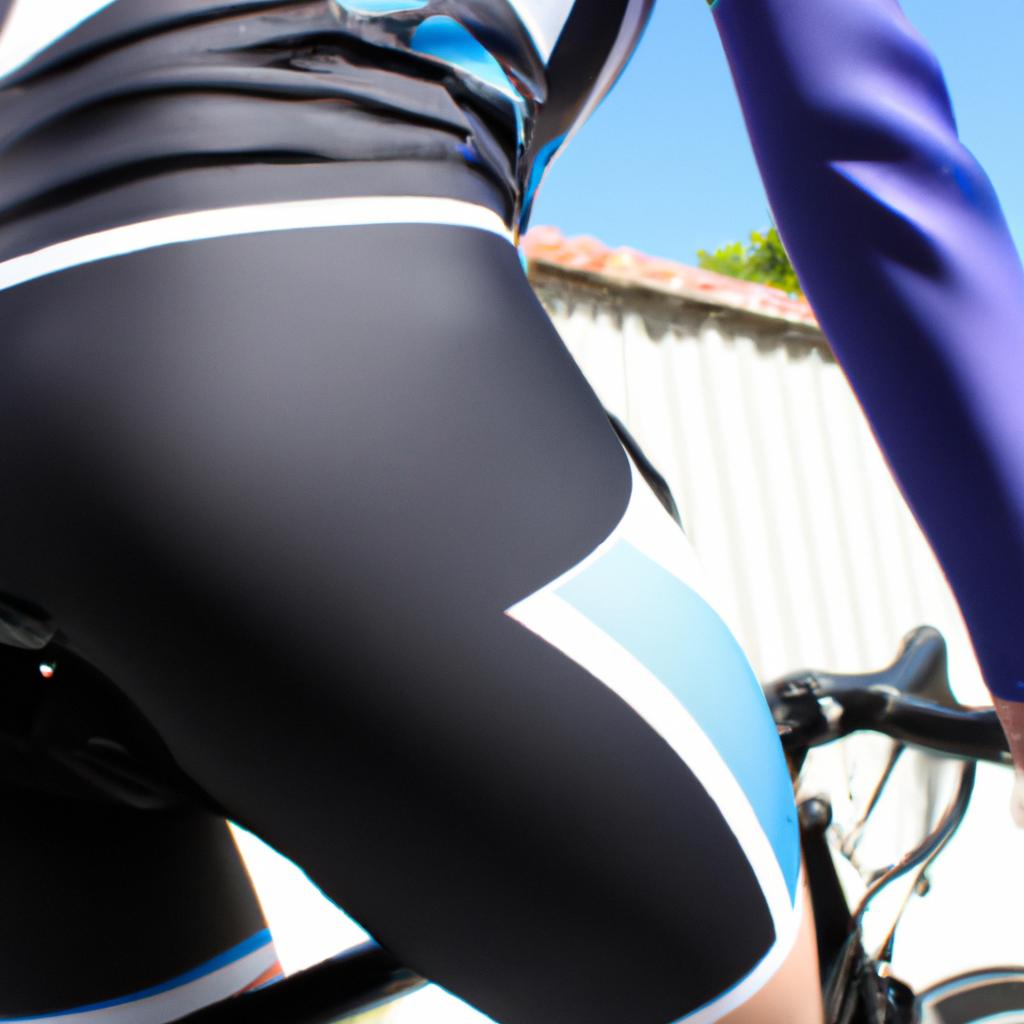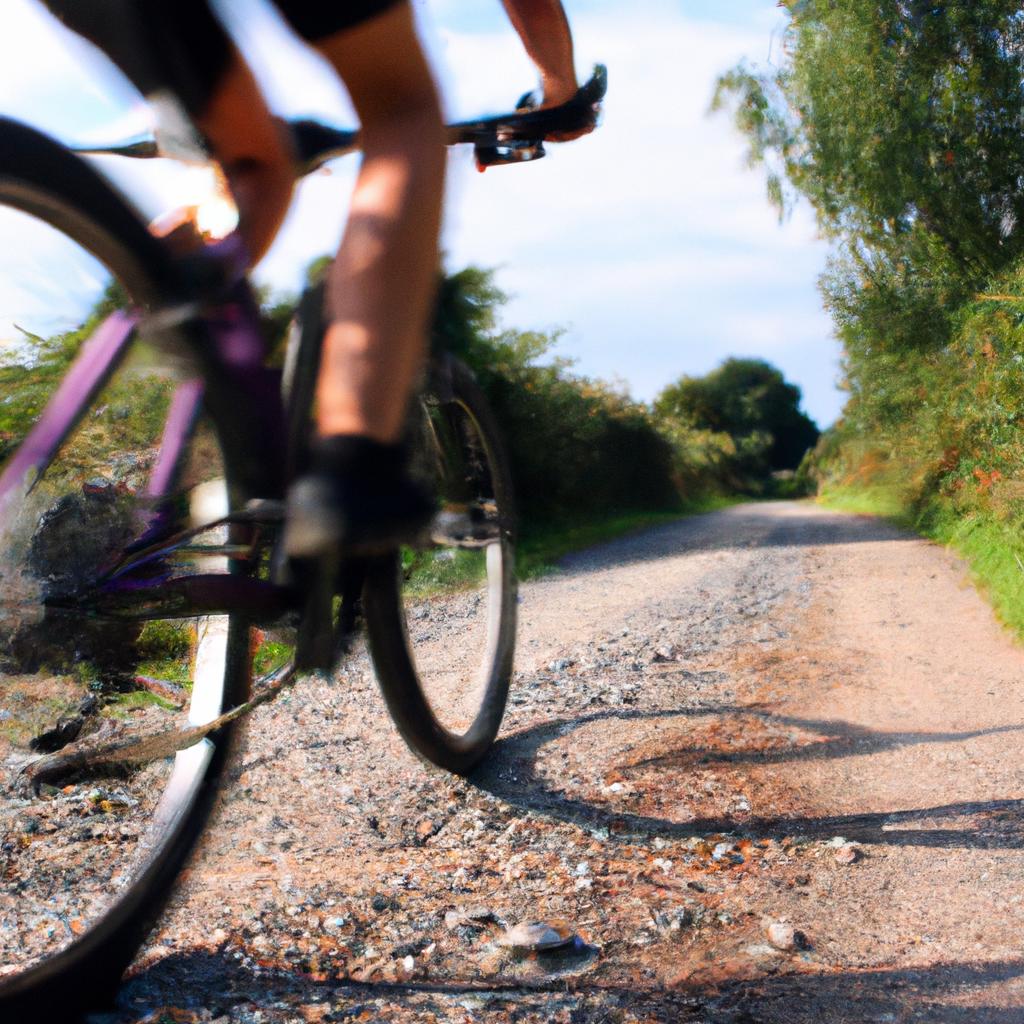Bicycle maintenance is a crucial aspect of ensuring optimal performance and longevity for all cycling enthusiasts. Whether one is an avid cyclist or simply enjoys the occasional ride, regular maintenance routines are essential to keep bicycles in top shape. For instance, consider the case of John, a dedicated cyclist who religiously rides his bike every day to commute to work. Despite investing in a high-quality bicycle, he soon noticed that its performance deteriorated over time due to neglecting proper maintenance practices. This article aims to provide comprehensive tips on bicycle maintenance, offering valuable insights into routine cleaning techniques, tire care, chain lubrication, brake adjustments, and overall safety measures.
To begin with, maintaining a clean bicycle is fundamental for both aesthetic purposes as well as functional reasons. A dirty bike not only looks unappealing but also affects its performance by accumulating debris and grime that can hinder smooth operation. Regular cleaning and inspection allow cyclists to identify potential issues such as loose parts or damaged components before they escalate into more serious problems. Additionally, understanding the importance of proper tire care can significantly impact riding experience and safety levels. By regularly checking tire pressure, inspecting tread wear patterns, and promptly addressing any punctures or leaks, cyclists can enhance traction on various terrains while minimizing the risk of flats or blowouts.
Furthermore, chain lubrication is a crucial aspect of bicycle maintenance that should not be overlooked. A well-lubricated chain ensures smooth shifting and pedaling efficiency, reducing wear and tear on both the chain and drivetrain components. It is recommended to clean the chain thoroughly before applying a suitable lubricant, ensuring that excess oil or dirt is wiped off to prevent attracting more debris during rides.
In addition to these routine maintenance tasks, brake adjustments are essential for optimal stopping power and rider safety. Regularly inspecting brake pads for signs of wear and replacing them when necessary ensures efficient braking performance. Adjusting brake tension and aligning calipers properly can also enhance responsiveness, allowing riders to confidently navigate various road conditions.
Lastly, prioritizing overall safety measures is imperative when it comes to bicycle maintenance. This includes regularly checking critical components such as handlebars, stem, pedals, and saddle for any signs of damage or loose fittings. Additionally, inspecting wheels for trueness (alignment) and spoke tension helps prevent wheel wobbles or potential failures during rides.
In conclusion, maintaining a bicycle through regular cleaning techniques, proper tire care, chain lubrication, brake adjustments, and overall safety measures is crucial for optimal performance and longevity. By incorporating these practices into their routine maintenance routines, cyclists can ensure an enjoyable riding experience while minimizing the risk of breakdowns or accidents caused by neglected upkeep.
Inspecting and Cleaning the Bike
Inspecting and Cleaning the Bike
Imagine you are a dedicated cyclist preparing for an adventurous ride along scenic trails. As you embark on your cycling journey, it is crucial to ensure that your bicycle is in optimal condition. In this section, we will explore the essential steps involved in inspecting and cleaning your bike, thereby enhancing its performance and longevity.
To begin with, let’s consider the importance of regular inspections. By thoroughly examining various components of your bike, such as the frame, tires, chain, and brakes, you can identify any potential issues before they escalate into major problems. For instance, imagine discovering a worn-out tire during a routine inspection rather than experiencing a sudden blowout while speeding down a steep hill. This example illustrates the significance of preventive maintenance in ensuring both safety and enjoyment while riding.
When it comes to cleaning your bike, there are several benefits beyond just aesthetics. Proper cleaning removes dirt and grime that may accumulate over time and impede functionality. Additionally, maintaining cleanliness helps prevent rust formation on metal parts due to exposure to moisture or corrosive elements present outdoors. Here are some key points to keep in mind when cleaning your bike:
- Use mild soap or specialized bike cleaners: Avoid using harsh chemicals that could damage paintwork or degrade lubricants.
- Scrub gently but thoroughly: Pay attention to hard-to-reach areas like cogs and derailleurs.
- Rinse with clean water: Ensure all remnants of soap or cleaner are completely removed.
- Dry carefully: Wipe off excess moisture with a soft cloth to prevent corrosion.
Moreover, incorporating visual aids effectively conveys important information about bicycle maintenance. Consider the following table summarizing common wear signs observed during inspections:
| Component | Wear Signs |
|---|---|
| Tires | Balding tread |
| Chain | Rust |
| Brakes | Excessive pad wear |
| Frame | Cracks or dents |
By referring to this table, cyclists can easily identify signs of wear and take appropriate action promptly. This visual representation enhances the reader’s understanding while also evoking an emotional response towards ensuring their bike is in excellent condition.
In preparation for our next section on “Checking and Adjusting the Brakes,” it is important to note that inspecting and cleaning your bike play a vital role in overall maintenance. By following these steps diligently, you not only ensure optimal performance but also extend the lifespan of your beloved two-wheeled companion. So let us now transition seamlessly into exploring how to effectively check and adjust the brakes without missing a beat.
Checking and Adjusting the Brakes
After thoroughly inspecting your bike, it is now time to move on to another crucial aspect of bicycle maintenance – checking and adjusting the brakes. Imagine this scenario: you are cycling down a steep hill when suddenly, you need to make an emergency stop. Your heart races as you apply pressure to the brake lever, but instead of slowing down quickly and safely, your bike continues to gather speed. This unnerving situation highlights the importance of properly maintaining your brakes.
To ensure optimal braking performance and rider safety, here are some key steps to follow:
- Check Brake Pads: Examine the condition of your brake pads regularly. Over time, they can wear out or become contaminated with dirt and debris. Replace any worn-out or damaged pads immediately.
- Inspect Brake Cables: Inspect both the brake cables for fraying or kinks that may impede their functionality. If necessary, lubricate them using appropriate cable lubricants.
- Adjust Brake Tension: Use the barrel adjusters located near each brake lever to fine-tune the tension in your brake system. Ensure that there is enough clearance between the brake pads and rims while also maintaining sufficient stopping power.
- Test Braking Performance: After making adjustments, take your bike for a test ride in a safe area where you can gradually increase speed before applying the brakes. Pay attention to how quickly and smoothly your bike comes to a halt.
By following these guidelines, you can enhance the reliability of your braking system and minimize potential accidents caused by poor brake performance.
| Common Brake Issues | Possible Causes | Solutions |
|---|---|---|
| Squealing noises | Contaminated brake pads | Clean/replace pads |
| Weak braking power | Worn-out brake pads | Replace pads |
| Inconsistent response | Loose brake cables | Adjust/tighten cables |
| Excessive brake drag | Misaligned brake calipers | Align/calibrate brakes |
Now that we have covered inspecting and cleaning the bike, let’s move on to maintaining another essential component – the chain and drivetrain. The chain is responsible for transferring power from your legs to the wheels, making it crucial to keep it in good condition.
[Transition Sentence] To ensure smooth gear shifting and maximum efficiency while pedaling, regular maintenance of the chain and drivetrain is necessary.Maintaining the Chain and Drivetrain
Transitioning from checking and adjusting the brakes, it is crucial for cycling enthusiasts to pay equal attention to maintaining their bicycle’s chain and drivetrain. Neglecting these components can result in poor performance, increased wear, and even potential accidents. To illustrate this point, let us consider a hypothetical scenario where a cyclist experiences frequent slipping of gears while riding uphill due to an improperly maintained chain.
To ensure the optimal functioning of your bicycle’s chain and drivetrain, follow these essential tips:
-
Regular Cleaning:
- Remove any dirt or debris by using a brush or cloth.
- Apply a specialized degreaser to dissolve stubborn grime.
- Rinse with water and dry thoroughly before lubricating.
-
Proper Lubrication:
- Choose a suitable bike chain lubricant based on your riding conditions (e.g., wet or dry).
- Apply a moderate amount of lubricant along the entire length of the chain.
- Wipe off excess oil to prevent attracting more dirt during rides.
-
Tension Adjustment:
- Check the tension of your bike’s chain regularly.
- Ensure that there is slight slack when pushing down on the lower section of the chain (around 0.5-1 cm).
- If necessary, adjust the tension by loosening or tightening the rear wheel axle nuts accordingly.
-
Inspection and Replacement:
- Monitor for signs of excessive wear such as elongated links, rust, or loose pins.
- Replace worn-out chains promptly to avoid damaging other drivetrain components like cassette cogs or chainrings.
Implementing these maintenance practices will not only extend the lifespan of your bicycle’s chain and drivetrain but also enhance your overall cycling experience.
In continuation with proper bicycle upkeep, our next section will focus on monitoring and inflating tires effectively without compromising safety or performance.
Monitoring and Inflating the Tires
Continuing with our bicycle maintenance guide, let’s now shift our focus to an equally critical aspect of keeping your bike in top shape – monitoring and inflating the tires. Proper tire maintenance not only ensures a smooth and comfortable ride but also plays a significant role in preventing accidents caused by tire-related issues.
Consider this hypothetical scenario: Sarah, an avid cyclist, decides to embark on a long-distance cycling adventure. Excitedly setting off on her journey, she soon encounters difficulties as her bike starts losing stability due to underinflated tires. This situation could have been easily avoided had Sarah paid attention to regular tire checks and proper inflation techniques.
To maintain optimal performance and safety levels, here are some essential tips:
-
Regular Inspection:
- Check tire pressure using a reliable gauge before each ride.
- Inspect the tread depth regularly; worn-out treads can compromise grip on wet or slippery surfaces.
- Look out for any visible damage such as cuts or bulges that may indicate potential punctures or blowouts.
-
Correct Tire Pressure:
- Refer to your bike manufacturer’s guidelines or sidewall markings for recommended pressure range (in PSI or BAR).
- Underinflation leads to increased rolling resistance, making pedaling harder while increasing the risk of flats.
- Overinflation reduces traction on uneven surfaces, leading to decreased control over your bike.
-
Puncture Prevention:
- Consider using quality puncture-resistant tires or inserts designed to minimize flat occurrences.
- Avoid riding through debris-filled areas if possible and take extra caution when encountering sharp objects on the road.
-
Emergency Repair Kit:
Ensure you carry a basic repair kit including spare inner tubes, tire levers, and a portable pump or CO2 inflator for quick fixes while on the go.
By following these guidelines and regularly monitoring your bike tires, you can significantly reduce the risk of accidents caused by tire-related issues. In our next section, we will delve into examining and lubricating the moving parts of your bicycle to ensure its overall smooth functioning and longevity.
Examining and Lubricating the Moving Parts
Section H2: Examining and Lubricating the Moving Parts
Transitioning seamlessly from our discussion on monitoring and inflating the tires, let us now turn our attention to examining and lubricating the moving parts of your beloved bicycle. To illustrate the importance of this maintenance task, consider a hypothetical scenario where an avid cyclist named Alex neglects regular examination and lubrication. Over time, Alex notices increased resistance while pedaling, odd noises arising from the bike’s components, and even difficulty shifting gears smoothly. These issues not only compromise performance but also pose safety hazards.
To ensure smooth operation and extend the lifespan of your bicycle, it is crucial to regularly examine and lubricate its moving parts. Here are some essential tips:
- Inspecting: Begin by visually inspecting all moving parts such as chains, derailleurs, cables, pedals, bottom brackets, and wheel hubs for signs of wear or damage.
- Cleaning: Use a soft brush or cloth to remove any dirt or debris accumulated on these parts before proceeding with lubrication.
- Lubricating: Apply a suitable lubricant specifically designed for bicycles onto each component that requires lubrication. This includes chains, derailleur pivot points, brake levers’ pivots, cable housings (if applicable), pedal spindles, and bearings.
By following these meticulous steps in examining and lubricating your bicycle’s moving parts, you can significantly enhance its overall performance and longevity.
Now let us explore further strategies in ensuring optimum care for your two-wheeled companion by delving into effective methods of storing and protecting your bike without compromising valuable space or convenience.
Storing and Protecting the Bike
Now let us delve further into this topic by exploring some essential tips that every cycling enthusiast should know.
Imagine a scenario where you have just finished an exhilarating ride through rough terrains, only to find that your bike’s gears are not shifting smoothly anymore. This can be quite frustrating, especially if you’re planning to embark on another adventure soon. By following these maintenance practices, you can avoid such situations and keep your bike in top shape:
- Regularly inspect the drivetrain components: The drivetrain, consisting of the chain, cassette or freewheel, front and rear derailleurs, is crucial for smooth gear shifts. Inspect these components for any signs of wear or damage, such as rusted chains or bent derailleur hangers.
- Clean and lubricate the chain: A dirty chain can cause poor shifting performance and increase friction between moving parts. Use a degreaser to remove dirt and grime from the chain, then apply a suitable lubricant evenly along its length.
- Check brake pads for wear: Properly functioning brakes are vital for safety while riding. Examine the brake pads regularly to ensure they have sufficient thickness left; replace them if necessary.
- Grease pivot points on brakes and derailleurs: Applying grease to pivot points reduces friction and ensures smooth movement of both brakes and derailleurs.
To evoke an emotional response from readers who cherish their bikes dearly, here is a bullet point list highlighting how regular maintenance enhances their overall cycling experience:
- Increased reliability
- Enhanced performance
- Prolonged lifespan
- Improved safety during rides
Furthermore, consider this table showcasing different types of lubes that cyclists commonly use:
| Type | Pros | Cons |
|---|---|---|
| Wet lube | Provides excellent lubrication in wet conditions. | Attracts dirt and requires frequent cleaning. |
| Dry lube | Stays clean and reduces the accumulation of dust and debris. | Requires more frequent reapplication, especially in wet weather. |
| Ceramic lube | Offers superior lubrication and extended durability. | More expensive than other types of lubes. |
| Wax-based lube | Keeps the drivetrain exceptionally clean and offers smooth shifting. | May require a longer drying time after application. |
By carefully considering these factors when choosing a suitable lube for your bike, you can ensure optimal performance while addressing individual preferences.
In conclusion, examining and lubricating the moving parts of your bicycle is crucial for maintaining its overall functionality. By regularly inspecting components, cleaning and greasing pivot points, as well as selecting appropriate lubes, cycling enthusiasts can enjoy smoother rides with increased reliability, enhanced performance, prolonged lifespan, and improved safety on their cherished bicycles.
 Buzzez
Buzzez



